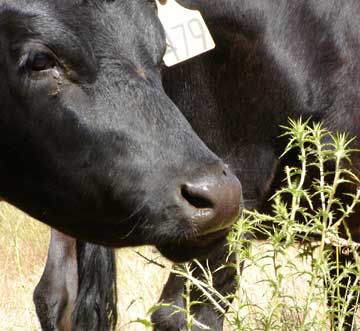New high quality feed discovered: Wooly Distaff Thistle
What if you could get rid of weeds without spraying, transforming them into valuable feed instead of something that costs you time and money? What if the answer to weed control was as simple as turning them into forage for your livestock? 
Those are the questions behind the seven steps developed by Kathy Voth to train cows to eat weeds. Taking advantage of 20 years of research describing how animals choose what they eat, she discovered a way to train cows to eat a new weed in as little as an hour a day for five days.
Voth, a research associate from Utah State University, first tested these steps in a pilot project at Grant-Kohrs Ranch National Historic Site in Deer Lodge, Montana. She trained cows to eat Canada thistle, leafy spurge, and spotted knapweed. Now, working with Peggy Rathmann and John Wick in Nicasio, and with Mike and Sally Gale of Chileno Valley Beef, Voth has successfully used these steps to train cows to eat Distaff and Italian thistle.
On May 9, cows at the Wick Rathmann Ranch first ate Distaff thistle from black tubs, and on June 3, after waiting for the distaff to bolt, the cows ate it in pasture even though there was plenty of grass nearby. Further test pastures are planned at the Gales’, where a small herd of heifers has been trained.
So how does this work? According to Voth, research shows that animals learn what to eat, making choices based on feedback from the nutrients and chemicals in forages. “We’ve found that most ‘weeds’ are as nutritious as alfalfa,” says Voth. “Once a cow tries it, she likes it.” Voth coaxes heifers to try new foods that they haven’t eaten before like alfalfa molasses meal, rolled corn, milo, etc. “Most people are surprised when a cow won’t eat something the first time she sees it, even though we all know it’s good for her,” says Voth.
Over a four-day period, cows are introduced to four different foods, often with a familiar flavor mixed in. On the fifth day Voth adds weeds mixed with one of the foods and flavors (generally molasses) they are used to. “We didn't think our 30 trainees would eat Distaff thistle the first time we gave it to them,” said project participant Peggy Rathmann. “But they ate it like crazy!”
For those wondering if they could simply spray their weeds with molasses without going through the short training process, Rathmann and Voth ran an experiment to see if cows without training would eat as much molasses-coated Distaff as cows with training. The results showed that training is really the key. Untrained animals ate only two ounces of the weed the first time they saw it, while trained animals ate 81 ounces.
What’s next for this multi-year project? “We’ve learned a lot this summer about how easy and fast it can be to teach a cow to eat a new weed, but there are still questions to be answered,” says Voth. “Folks want to be sure that weight gains are good for animals who eat these plants, so we’ll be monitoring that.” Voth notes that in 2004, heifers eating Canada thistle, leafy spurge and spotted knapweed gained an average of 4.5 pounds per day, so she anticipates similar results here. She'll also be monitoring changes in vegetation over time and working with animals to see what size pastures and times of year work best to maximize their consumption of target weeds. - Kathy Voth
Visit Kathy’s website for more information and current news. http://www.livestockforlandscapes.com/marin.htm.
Kathy will also be presenting a rough cut of a video describing this first year’s progress at Taste of Marin and will be presenting workshops in the fall. The workshops will be organized by UC Cooperative Extension. Stay tuned for the schedule posting at www.growninmarin.org



